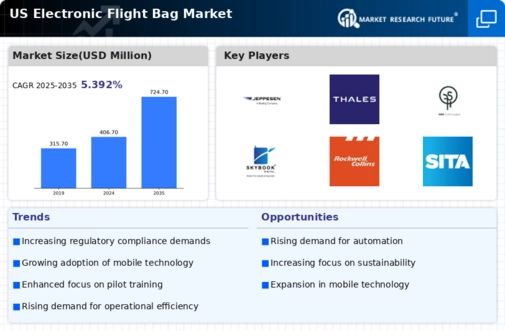Advancements in Mobile Technology
The rapid evolution of mobile technology is significantly influencing the electronic flight-bag market. With the proliferation of smartphones and tablets, pilots are increasingly utilizing these devices as electronic flight bags, which offer enhanced functionality and portability. The electronic flight-bag market is capitalizing on this trend, as mobile applications provide real-time weather updates, navigation assistance, and flight planning tools. According to recent data, the use of mobile devices in aviation has increased by over 40% in the past few years. This shift not only improves the efficiency of flight operations but also enhances the user experience for pilots. As mobile technology continues to advance, the electronic flight-bag market is expected to evolve, offering more sophisticated features and capabilities that cater to the needs of modern aviators.
Growing Focus on Safety and Compliance
Safety remains a paramount concern in the aviation sector, and the electronic flight-bag market is responding to this need. The industry is witnessing an increasing emphasis on compliance with safety regulations, which has led to the adoption of electronic flight bags that facilitate better documentation and reporting. For instance, the Federal Aviation Administration (FAA) mandates that pilots maintain accurate records, and electronic flight bags simplify this process by providing automated updates and alerts. This capability not only enhances safety but also ensures compliance with regulatory requirements. The electronic flight-bag market is thus likely to expand as more operators recognize the importance of integrating safety features into their flight operations. The potential for reducing human error through technology further underscores the relevance of electronic flight bags in enhancing overall aviation safety.
Integration of Artificial Intelligence
The integration of artificial intelligence (AI) into the electronic flight-bag market is emerging as a transformative driver. AI technologies are being utilized to enhance the functionality of electronic flight bags, providing predictive analytics and personalized recommendations for pilots. This advancement allows for improved situational awareness and decision-making during flights. The electronic flight-bag market is witnessing a trend where AI-driven applications can analyze vast amounts of data to optimize flight routes and improve fuel efficiency. As AI continues to evolve, its potential to revolutionize flight operations becomes increasingly apparent. The incorporation of AI into electronic flight bags may lead to enhanced safety, efficiency, and overall performance in aviation, suggesting a promising future for the electronic flight-bag market.
Increased Demand for Operational Efficiency
The electronic flight-bag market is experiencing a surge in demand driven by the aviation industry's quest for operational efficiency. Airlines and operators are increasingly adopting electronic flight bags to streamline flight operations, reduce paper usage, and enhance data accessibility. This shift is evidenced by a reported 30% reduction in flight preparation time when utilizing electronic flight bags compared to traditional methods. The electronic flight-bag market is thus positioned to benefit from this trend, as operators seek to optimize their workflows and minimize costs. Furthermore, the integration of real-time data analytics into electronic flight bags allows for improved decision-making, which is crucial in a competitive market. As airlines continue to prioritize efficiency, the electronic flight-bag market is likely to see sustained growth in demand.
Rising Fuel Costs and Environmental Concerns
The electronic flight-bag market is also being driven by rising fuel costs and growing environmental concerns. Airlines are under pressure to reduce operational costs, and electronic flight bags can play a crucial role in achieving this goal. By providing pilots with accurate flight data and optimizing flight paths, electronic flight bags can contribute to fuel savings of up to 10%. Additionally, the aviation industry is increasingly focused on sustainability, and the adoption of electronic flight bags aligns with efforts to minimize carbon footprints. The electronic flight-bag market is thus likely to see growth as airlines seek solutions that not only reduce costs but also support environmental initiatives. This dual focus on economic and ecological sustainability positions electronic flight bags as a vital tool in the modern aviation landscape.





















Leave a Comment